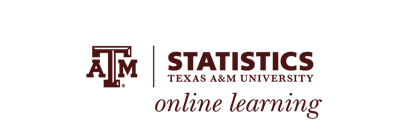For students in engineering, physical and mathematical sciences. Introduction to probability, probability distributions and statistical inference; hypotheses testing; introduction to methods of analysis such as tests of independence, regression, analysis of variance with some consideration of planned experimentation. Prerequisite: Two semesters of calculus. Multiple integration and elementary linear algebra are helpful. Credit 4.
Additonal Information
Additonal Information
Efficient uses of existing statistical computer programs (SAS, R, etc.); generation of random numbers; using and creating functions and subroutines; statistical graphics; programming of simulation studies; and data management issues. Credit 3.
Additional Information
Additional Information
Planning, execution, and analysis of sampling from finite populations; simple, stratified, multistage, and systematic sampling; ratio estimates. Prerequisite: STAT 601 or 652 or concurrent enrollment in STAT 641. Credit 3.
Additional Information
Additional Information
Multiple, curvilinear, nonlinear, robust, logistic and principal components regression analysis; regression diagnostics, transformations, analysis of covariance. Prerequisite: STAT 601 or 641. Credit 3.
Additional Information
Additional Information
Introduction to statistical time series analysis; autocorrelation and spectral characteristics of univariate, autoregressive, moving average models; identification, estimation and forecasting. Prerequisite: STAT 601 or 642 and a working knowledge of complex numbers and trigonometry. Credit 3.
Additional Information
Additional Information
Basic probability theory including distributions of random variables and their expectations. Introduction to the theory of statistical inference from the likelihood point of view including maximum likelihood estimation, confidence intervals, and likelihood ratio tests. Introduction to Bayesian methods. Prerequisite: Three semesters of calculus, including multiple integration and a basic understanding of limits. Credit 3.
Additional Information
Additional Information
Multivariate extensions of the chi-square and t-tests, discrimination and classification procedures. Applications to diagnostic problems in biological, medical, anthropological, and social research; multivariate analysis of variance, principal component and factor analysis, canonical correlations. Prerequisites: STAT 608 or 652. Credit 3.
Additional Information
Additional Information
The objective of this applied master’s level course is to introduce students to the Bayesian paradigm for data analysis. Students learn how uncertainty regarding parameters can be explicitly described as a posterior distribution which blends information from a sampling model and prior distribution. Students are exposed to foundational principles, but the course emphasizes modeling and computations under the Bayesian paradigm. Prerequisites: STAT 604, STAT 608 and STAT 630. Credit 3.
Additional Information
Additional Information
An application of the various disciplines in statistics to data analysis, introduction to statistical software; demonstration of interplay between probability models and statistical inference. Prerequisites: Two semesters of Calculus, STAT 604, and STAT 630.
Credit 3.
Additional Information
Credit 3.
Additional Information
Design and analysis of experiments; scientific method; graphical displays; analysis of non-conventional designs and experiments involving categorical data. Prerequisites: STAT 641. Credit 3.
Additional Information
Additional Information
Survey of crucial topics in biostatistics; application of regression in biostatistics;analysis of correlated data; logistic and Poisson regression for binary or count data; survival analysis for censored outcomes; design and analysis of clinical trials; sample size calculation by simulation; bootstrap techniques for assessing statistical significance; data analysis using R. Prerequisites: STAT 651, 652, and 659, or equivalent or prior approval of instructor. Credit 3.
Additional Information
Additional Information
An overview of relevant biological concepts and technologies of genomic/proteomic applications; methods to handle, visualize, analyze, and interpret genomic/proteomic data; exploratory data analysis for genomic/proteomic data; data preprocessing and normalization; hypotheses testing; classification and prediction techniques for using genomic/proteomic data to predict disease status. Prerequisites: STAT 604, 651, 652 or equivalent or prior approval of instructor.
Credit 3.
Additional Information
Credit 3.
Additional Information
Spatial correlation and its effects; spatial prediction (kriging); spatial regression; analysis of point patterns (tests for randomness and modelling patterns); subsampling methods for spatial data. Prerequisite: STAT 630 and STAT 608 or STAT 601 or equivalent. Credit 3.
Statistics in Research I. (3-0). Credit 3. For graduate students in other disciplines. A non-calculus exposition of the concepts, methods, and usage of statistical data analysis. T-tests, analysis of variance, and linear regression. Prerequisite: MATH 102 or equivalent. Credit 3.
Additional Information
*Cannot be used towards the Master’s degree. Can be used towards a certificate.
Additional Information
*Cannot be used towards the Master’s degree. Can be used towards a certificate.
Continuation of STAT 651. Concepts of experimental design, individual treatment comparisons, randomized blocks and factorial analysis, multiple regression, chi-square tests and a brief introduction to covariance, non-parametric methods, and sample surveys. Prerequisite: STAT 651. Credit 3.
Additional Information
*Cannot be used towards the Master’s degree. Can be used towards a certificate.
Additional Information
*Cannot be used towards the Master’s degree. Can be used towards a certificate.
The analysis of messy and complex data sets using analysis of variance, analysis of covariance and regression analysis. Transformations; regression diagnostics; nonlinear, robust, logistic and principal components regression; structural equations. Prerequisite: STAT 642 or 652. Credit 3.
Additional Information
Additional Information
Applied Analytics Using SAS Enterprise Miner: Introduction to data mining and will demonstrate the procedures; Optimal prediction decisions; comparing and deploying predictive models; neural networks; constructing and adjusting tree models; the construction and evaluation of multi-stage models. NOTE: For this course, you will be required to have a computer with a Windows OS and good processing power. Prerequisite: STAT 657 and 659 or instructor approval. Credit 3.
Additional Information
Additional Information
Programming with SAS/IML, programming in SAS Data Step, advanced use of various SAS procedures. Prerequisite: STAT 604 and STAT 630 or 652. Credit 3.
Additional Information
Additional Information
Introduction to analysis and interpretation of categorical data using ANOVA/regression analogs; includes contingency tables, loglinear models, logistic regression; use of computer software such as SAS, GLIM, SPSSX. Prerequisite: STAT 601 or 652 or 642 or 608 Credit 3.
Additional Information
Additional Information


See how Social we are!